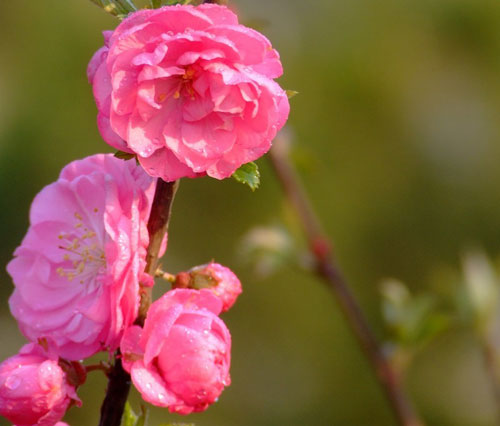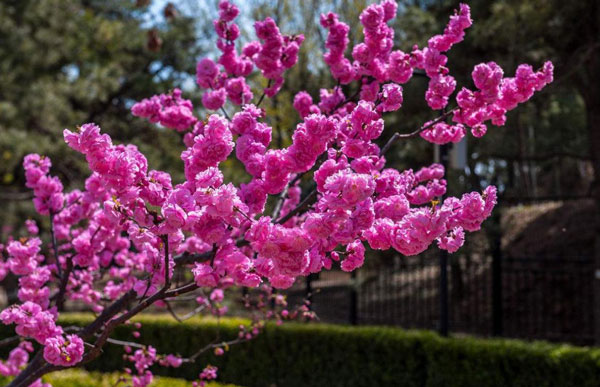Prunus Triloba: Grow & Care for Prunus Triloba
Written by Iris
Jul 31 2021
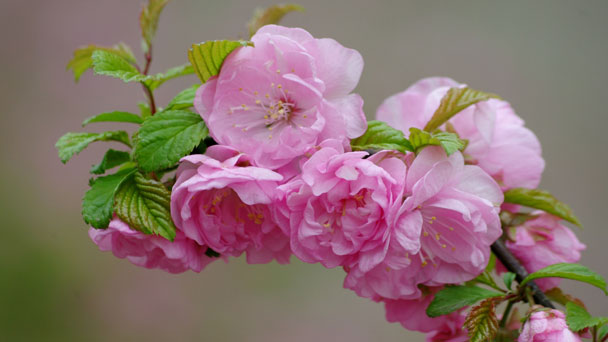
The flowering of the flowering plum blossoms resemble peach blossoms, but the leaves have deep veins and thick serrations like elm trees. The flowering plum blossoms have dense branches and colorful flowers, and are important flower-viewing shrubs in spring gardens in northern China. It has strong resistance to salt and alkali, and is suitable for planting on park grass, roadside, corners of gardens, poolsides, etc. If the flowering plum is planted in front of evergreen trees, or planted on rocks and hills, it can produce good ornamental effects.
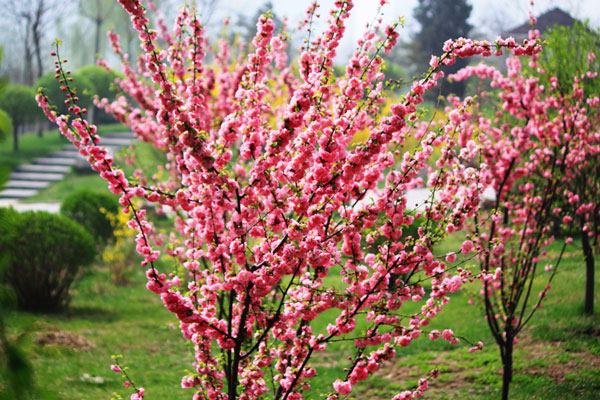
There are two grafting methods, bud grafting and grafting, and bud grafting is generally used. Bud grafting should be carried out in mid-to-late August. The plump leaf buds from the annual branches can be selected from the fine varieties of Yuyemei plants. Technical transfer should take place in the spring from February to March. The scion should be cut before the plant germinates. Dongjin can also intercept the scion and store it in sand for use in spring. Layering should be carried out in the spring from February to February. Two-year-old branches can be selected. In the part buried in the soil, the branches are partially cut or stripped in a ring to facilitate the budding roots. It usually takes a month to take root. Grafting mostly uses seedlings of mountain apricots, mountain peaches, and flowering plums that are 1 to 2 years old as rootstocks. In spring, the buds are cut and spliced before germination; the buds are spliced from July to August; the splicing can be before June, and it can be separated from the mother plant after healing in 1 to 2 months. Seeds are sown in autumn when they are mature, or in spring after sand is stored. It can be planted after falling leaves in autumn and before buds germinate in early spring. Attention should be paid to pruning and fertilizing after flowering to ensure that there are enough flowering branches in the coming year.
The branching method can be carried out before the plants germinate after the soil is thawed in autumn and spring. After ramified plants, 1/3-1/2 branches should be cut to reduce water evaporation, which is conducive to plant survival.
Cutting substrate: it is the nutrient soil or river sand, peat soil and other materials used for cutting. Family cuttings are limited in conditions and it is difficult to obtain an ideal cutting substrate. It is recommended to use a prepared and sterilized cutting substrate; medium coarse river sand is also acceptable, but it should be rinsed with water several times before use. Do not use sea sand and river sand in saline-alkali areas. They are not suitable for the growth of flowers and plants.
Selection of cuttings: When making softwood cuttings, when the plants grow vigorously in late spring to early autumn, choose the thick and robust branches of the year as cuttings. After cutting off the branches, select the strong parts and cut them into sections with a length of 5 to 15 cm. Each section should have more than 3 leaf nodes. When cutting cuttings, it should be noted that the upper cut is cut flat about 1 cm above the top leaf node, and the lower cut is cut diagonally about 0.5 cm below the bottom leaf node. Both upper and lower cuts are cut flat. To be flat (knife to be sharp). When making hard cuttings, after the temperature rises in early spring, select last year's robust cuttings as cuttings. Each cutting segment usually retains 3 to 4 nodes, and the cutting method is the same as that of softwood cuttings.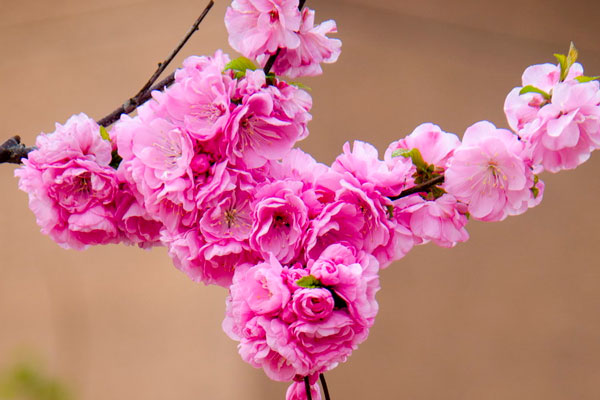
How to Choose and Prepare a Planting SiteHow to Grow Flowering PlumPrunus Triloba Cutting propagationPrunus Triloba Layering reproductionHow to Care for Flowering PlumPrunus Triloba FAQ
How to Choose and Prepare a Planting Site
Choose an appropriate size flower pot, and cover the bottom hole of the pot with two tiles or a thin foam sheet. It is necessary to ensure that the pot soil is not washed out by water, but also to allow the excess water to flow out in time. Put a layer of ceramsite or broken red bricks on the tiles or foam as a water filter layer, about 2 to 3 cm thick. Put a fertilizer machine fertilizer on the drainage layer, about 1 to 3 cm thick, and a thin layer of substrate on the fertilizer, about 2 cm thick, to separate the root system from the fertilizer, and finally put the plant in, fill the nutrient soil, and leave the pot. About 2 to 3 cm left in the mouth.
How to Grow Flowering Plum
The flowering plum can be reproduced by ramification, grafting, layering, cutting, seeding and other methods. Among them, ramets and grafting methods are used for reproduction.There are two grafting methods, bud grafting and grafting, and bud grafting is generally used. Bud grafting should be carried out in mid-to-late August. The plump leaf buds from the annual branches can be selected from the fine varieties of Yuyemei plants. Technical transfer should take place in the spring from February to March. The scion should be cut before the plant germinates. Dongjin can also intercept the scion and store it in sand for use in spring. Layering should be carried out in the spring from February to February. Two-year-old branches can be selected. In the part buried in the soil, the branches are partially cut or stripped in a ring to facilitate the budding roots. It usually takes a month to take root. Grafting mostly uses seedlings of mountain apricots, mountain peaches, and flowering plums that are 1 to 2 years old as rootstocks. In spring, the buds are cut and spliced before germination; the buds are spliced from July to August; the splicing can be before June, and it can be separated from the mother plant after healing in 1 to 2 months. Seeds are sown in autumn when they are mature, or in spring after sand is stored. It can be planted after falling leaves in autumn and before buds germinate in early spring. Attention should be paid to pruning and fertilizing after flowering to ensure that there are enough flowering branches in the coming year.
The branching method can be carried out before the plants germinate after the soil is thawed in autumn and spring. After ramified plants, 1/3-1/2 branches should be cut to reduce water evaporation, which is conducive to plant survival.
Prunus Triloba Cutting propagation
Twig cuttings are often used in the late spring and early autumn with the twigs that were born in the past, or old branch cuttings are used in the early spring with the branches that were born last year.Cutting substrate: it is the nutrient soil or river sand, peat soil and other materials used for cutting. Family cuttings are limited in conditions and it is difficult to obtain an ideal cutting substrate. It is recommended to use a prepared and sterilized cutting substrate; medium coarse river sand is also acceptable, but it should be rinsed with water several times before use. Do not use sea sand and river sand in saline-alkali areas. They are not suitable for the growth of flowers and plants.
Selection of cuttings: When making softwood cuttings, when the plants grow vigorously in late spring to early autumn, choose the thick and robust branches of the year as cuttings. After cutting off the branches, select the strong parts and cut them into sections with a length of 5 to 15 cm. Each section should have more than 3 leaf nodes. When cutting cuttings, it should be noted that the upper cut is cut flat about 1 cm above the top leaf node, and the lower cut is cut diagonally about 0.5 cm below the bottom leaf node. Both upper and lower cuts are cut flat. To be flat (knife to be sharp). When making hard cuttings, after the temperature rises in early spring, select last year's robust cuttings as cuttings. Each cutting segment usually retains 3 to 4 nodes, and the cutting method is the same as that of softwood cuttings.
Prunus Triloba Layering reproduction
Select strong branches and peel off the bark from about 15 to 30 cm below the top tip. The width of the wound after peeling is about 1 cm, and the depth is limited to the skin just peeled off. Cut a piece of film 10-20 cm long and 5-8 cm wide. Put some wet garden soil on it and wrap the girdling part like a wound. Tie the upper and lower ends of the film tightly and bulge in the middle. Take root in about four to six weeks. After rooting, cut off the roots of the branches together to form a new plant.
How to Care for Flowering Plum
Light
Like sunshine, it can give plenty of sunshine in the three seasons of autumn, winter and spring. When putting it indoors for maintenance, try to put it in a place with bright light, such as a well-lit living room, bedroom, study and other places. After a period of indoor maintenance (about a month), it is necessary to move it to an outdoor shaded place (with insulation conditions in winter) for maintenance for a period of time (about a month), and so alternately.Soil
Lax requirements on the soil, strong environmental adaptabilityWater
Water should be poured 2-3 times in dry weather, and attention should be paid to drainage in rainy seasonTemperature and Humidity
Like a slightly humid or dry climate environment, the relative temperature of the air in the growth environment is required to be 50-70%. Like a warm climate, but the high temperature and sultry environment in summer (above 35℃, relative humidity of the air above 80%) is not conducive to its growth; the temperature requirements in winter are very strict, when the ambient temperature is below 10℃, it stops growing, and under frost Can't survive the winter safely.Fertilizer
During the flower bud differentiation period in summer, apply fertilizer once before winterPruning
The pruning after the formation of the basic crown culture is mainly divided into summer pruning and winter pruning. Summer pruning is generally carried out in June after the flowers die. It is mainly to top off the branches that are too long, and cut the branches that have already bloomed. Only 3 or 4 buds at the base are left to make the newly germinated branches close to the main stem, which is conducive to plant shaping; winter pruning is generally carried out from December to February of the following year, mainly by cutting off dense branches, cross branches, and Overlapping branches, drooping branches, inner-bore branches, dead branches, and diseased branches; some long flowering branches can also be shortened. Some branches that are too densely branched and the branches of the previous year that are not prepared for flowering should be thinned out. After such a reasonable pruning, the flowering plum blossoms are not only large, but also have a long flowering period. It should be noted that the residual flowers should be cut off in time after the flowers wither, so as not to consume nutrients as a result. This is often neglected due to the limitation of manpower. In fact, cutting off the residual flowers is very necessary and meaningful.Pests and Diseases
Common insect pests of flowering plum are: aphids, red spiders, spiny moths, scale insects, leafhoppers, fragrant codling moths, longhorn beetles and so on. If it happens, use 1500 times solution of shoveling aphids to kill aphids; 40% dicofol EC 1500 times solution to kill red spiders; use Bt emulsion 1000 times solution to kill stinging moths; use 2.5% Dichloride EC to kill leaves Jumping cicadas; to kill the fragrant codling moths, you can inject 400 times solution of zinc sulfur and phosphorus into the insect channel and block the worm holes with mud to smoke and kill the larvae. You can also use carbofuran root burying to kill; you can use green velvet 500 times liquid to control longicorn beetle.Prunus Triloba FAQ
Is Prunus triloba fruit edible?
It is possible edible. The fruit is about 13mm in diameter and contains one large seed. Seed - raw or cooked. Do not eat the seed if it is too bitter - see the notes above on toxicity.How big does a Prunus triloba grow?
Reaching up to 3m in height this tree is a perfect choice for restricted space and smaller gardens. Enjoys sun or partial shade in moist well-drained soil.
Latest Updated
- Benefits of Bugleweed - 7 Science-backed Health Benefits
- Bugleweed Dangers & Side Effects - Is It Poisonous?
- How to Plant Evergreen Trees - What You Should Know
- When to Plant Evergreens - Grow Guide for Evergreen Trees
- 12 Wonderful Evergreen Shrubs for Your Garden
- 12 Popular Evergreen Plants with Pictures for Beginners
- When And How To Prune A Lilac Bush Like a Pro
- How to Grow & Care for Lilac Vine (Hardenbergia Violacea)
- Japanese Lilac Tree (Syringa Reticulata) Care & Propagation Guide
- Shumard Oak Pros and Cons - What to Know
Popular Articles
- Winter maintenance of Antirrhinum Majus
- How to Grow Terminalia Mantaly Tree
- How to Grow and Care for Crossostephium Chinense
- How to grow Antirrhinum Majus in spring
- Peristeria Elata (Dove Orchid) Profile: Info & Care Guide
- Underwatered Snake Plant (Sansevieria Trifasciata) - Signs And How To Fix
- How to Care for Brazilian Jasmine Plant (Mandevilla Sanderi)
- How to Grow & Care for Graptopetalum Purple Delight in Summer
- Rosa Chinensis (China Rose): Plant Growing & Care Tips
- How to Care for Baby Sun Rose (Aptenia Cordifolia)
